Communication and Diversity: Understanding Personal Bias and Its Consequences
VerifiedAdded on 2023/06/10
|7
|1975
|283
AI Summary
This article discusses personal bias and its consequences in healthcare, with a focus on the Australian Aboriginal community. It explores the role of media and societal influences in perpetuating biased views and the importance of developing cultural competence in healthcare professionals. The article also includes a personal experience of bias and reflection on assumptions made about an Aboriginal patient.
Contribute Materials
Your contribution can guide someone’s learning journey. Share your
documents today.
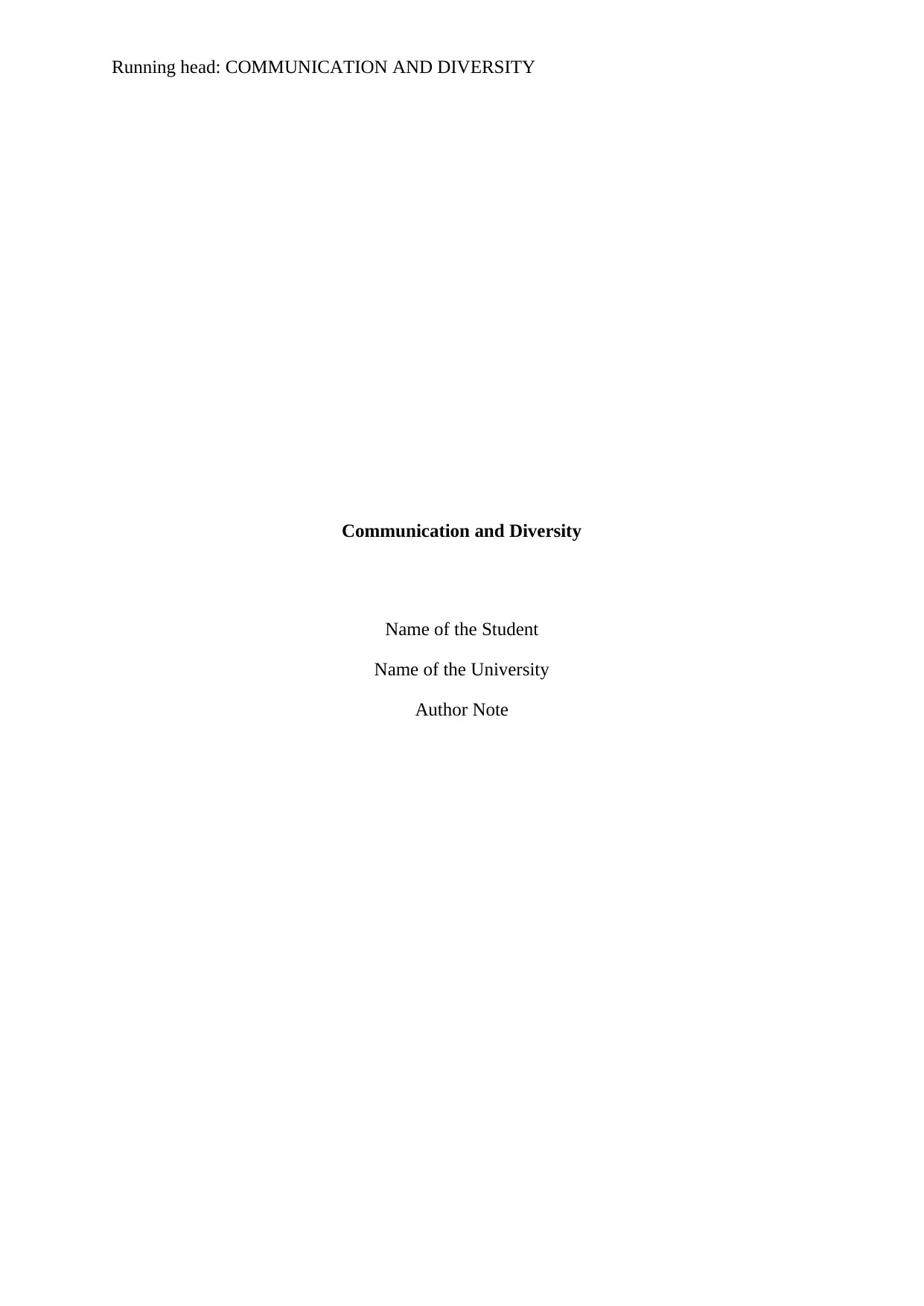
Running head: COMMUNICATION AND DIVERSITY
Communication and Diversity
Name of the Student
Name of the University
Author Note
Communication and Diversity
Name of the Student
Name of the University
Author Note
Secure Best Marks with AI Grader
Need help grading? Try our AI Grader for instant feedback on your assignments.
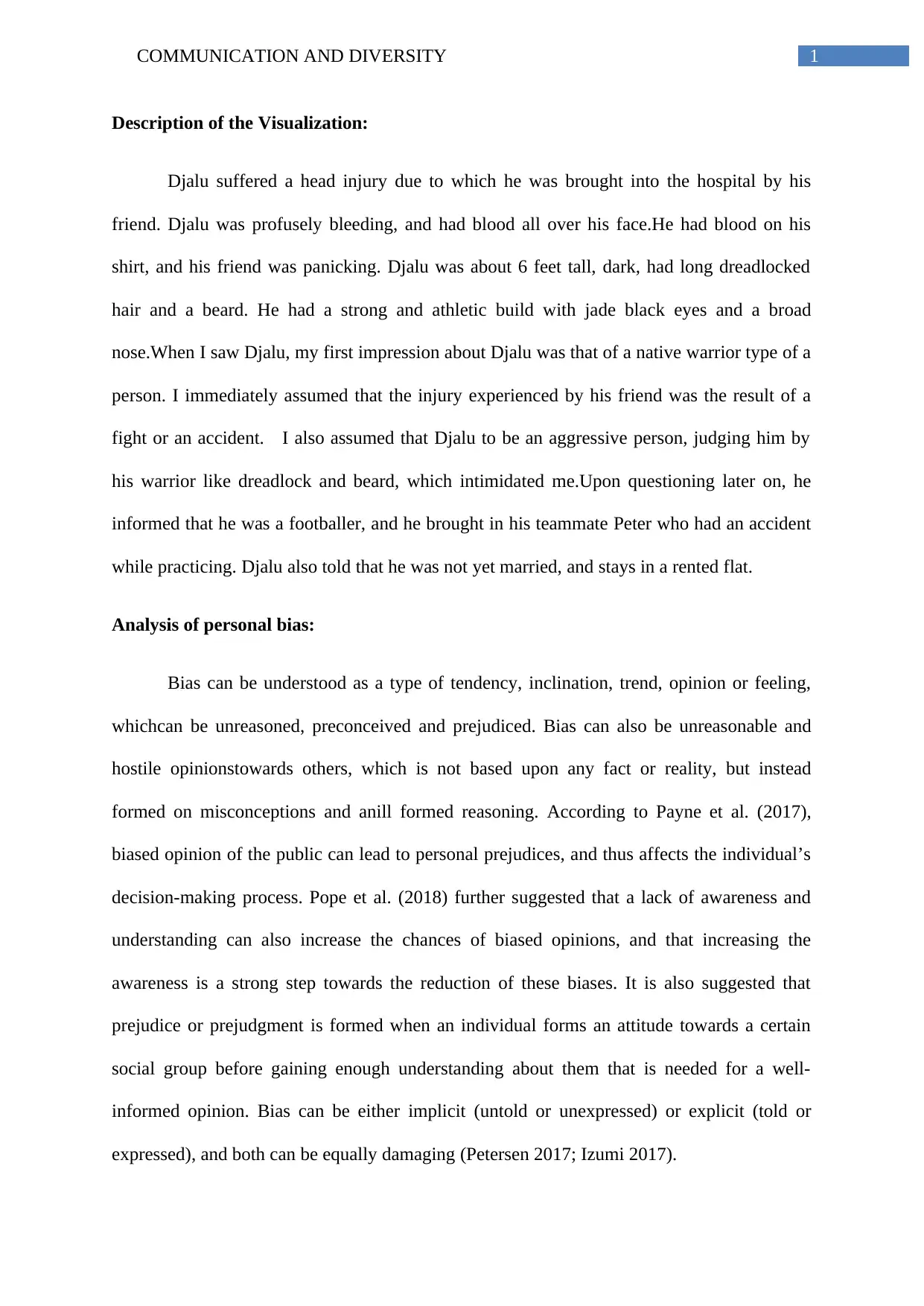
1COMMUNICATION AND DIVERSITY
Description of the Visualization:
Djalu suffered a head injury due to which he was brought into the hospital by his
friend. Djalu was profusely bleeding, and had blood all over his face.He had blood on his
shirt, and his friend was panicking. Djalu was about 6 feet tall, dark, had long dreadlocked
hair and a beard. He had a strong and athletic build with jade black eyes and a broad
nose.When I saw Djalu, my first impression about Djalu was that of a native warrior type of a
person. I immediately assumed that the injury experienced by his friend was the result of a
fight or an accident. I also assumed that Djalu to be an aggressive person, judging him by
his warrior like dreadlock and beard, which intimidated me.Upon questioning later on, he
informed that he was a footballer, and he brought in his teammate Peter who had an accident
while practicing. Djalu also told that he was not yet married, and stays in a rented flat.
Analysis of personal bias:
Bias can be understood as a type of tendency, inclination, trend, opinion or feeling,
whichcan be unreasoned, preconceived and prejudiced. Bias can also be unreasonable and
hostile opinionstowards others, which is not based upon any fact or reality, but instead
formed on misconceptions and anill formed reasoning. According to Payne et al. (2017),
biased opinion of the public can lead to personal prejudices, and thus affects the individual’s
decision-making process. Pope et al. (2018) further suggested that a lack of awareness and
understanding can also increase the chances of biased opinions, and that increasing the
awareness is a strong step towards the reduction of these biases. It is also suggested that
prejudice or prejudgment is formed when an individual forms an attitude towards a certain
social group before gaining enough understanding about them that is needed for a well-
informed opinion. Bias can be either implicit (untold or unexpressed) or explicit (told or
expressed), and both can be equally damaging (Petersen 2017; Izumi 2017).
Description of the Visualization:
Djalu suffered a head injury due to which he was brought into the hospital by his
friend. Djalu was profusely bleeding, and had blood all over his face.He had blood on his
shirt, and his friend was panicking. Djalu was about 6 feet tall, dark, had long dreadlocked
hair and a beard. He had a strong and athletic build with jade black eyes and a broad
nose.When I saw Djalu, my first impression about Djalu was that of a native warrior type of a
person. I immediately assumed that the injury experienced by his friend was the result of a
fight or an accident. I also assumed that Djalu to be an aggressive person, judging him by
his warrior like dreadlock and beard, which intimidated me.Upon questioning later on, he
informed that he was a footballer, and he brought in his teammate Peter who had an accident
while practicing. Djalu also told that he was not yet married, and stays in a rented flat.
Analysis of personal bias:
Bias can be understood as a type of tendency, inclination, trend, opinion or feeling,
whichcan be unreasoned, preconceived and prejudiced. Bias can also be unreasonable and
hostile opinionstowards others, which is not based upon any fact or reality, but instead
formed on misconceptions and anill formed reasoning. According to Payne et al. (2017),
biased opinion of the public can lead to personal prejudices, and thus affects the individual’s
decision-making process. Pope et al. (2018) further suggested that a lack of awareness and
understanding can also increase the chances of biased opinions, and that increasing the
awareness is a strong step towards the reduction of these biases. It is also suggested that
prejudice or prejudgment is formed when an individual forms an attitude towards a certain
social group before gaining enough understanding about them that is needed for a well-
informed opinion. Bias can be either implicit (untold or unexpressed) or explicit (told or
expressed), and both can be equally damaging (Petersen 2017; Izumi 2017).
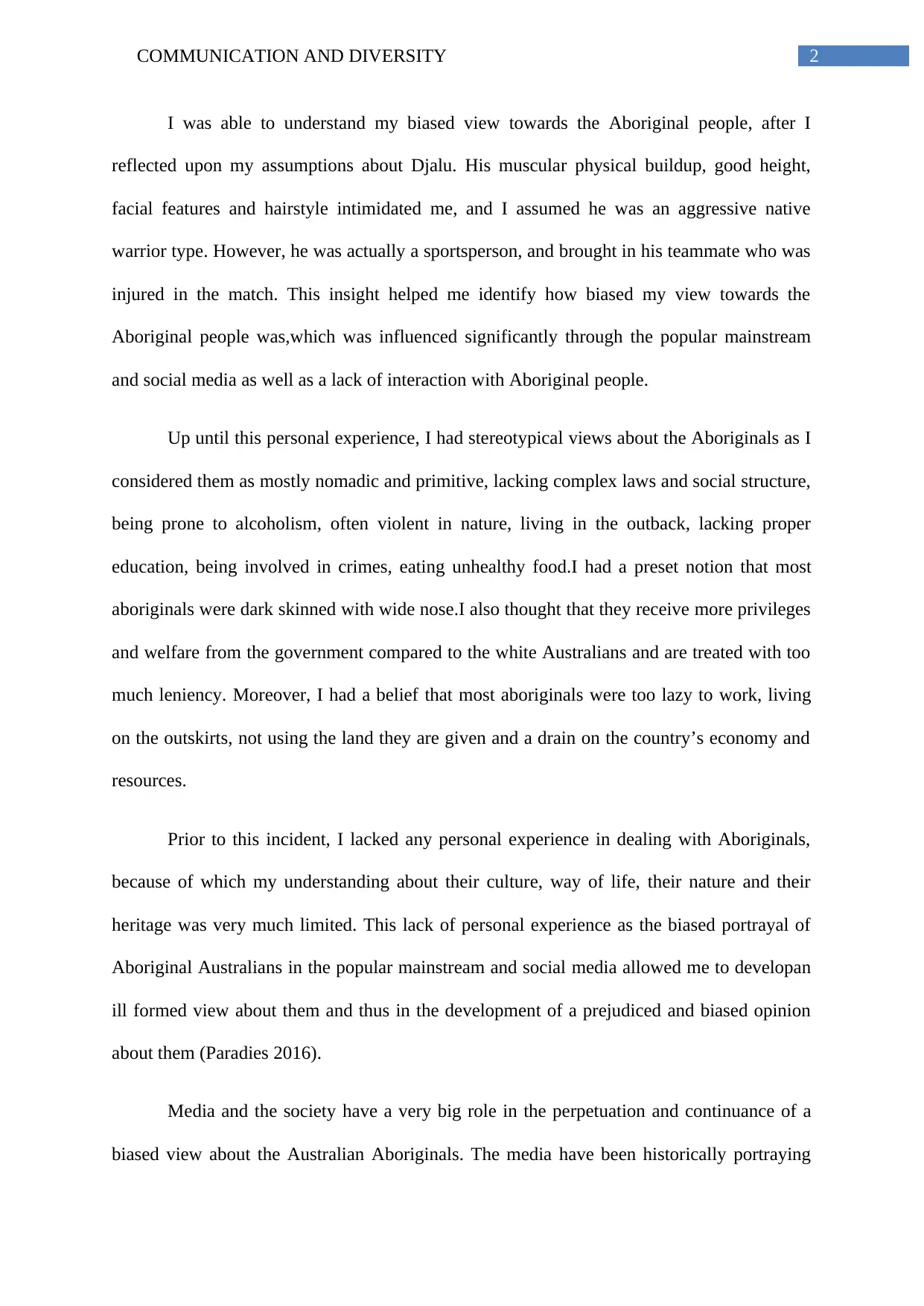
2COMMUNICATION AND DIVERSITY
I was able to understand my biased view towards the Aboriginal people, after I
reflected upon my assumptions about Djalu. His muscular physical buildup, good height,
facial features and hairstyle intimidated me, and I assumed he was an aggressive native
warrior type. However, he was actually a sportsperson, and brought in his teammate who was
injured in the match. This insight helped me identify how biased my view towards the
Aboriginal people was,which was influenced significantly through the popular mainstream
and social media as well as a lack of interaction with Aboriginal people.
Up until this personal experience, I had stereotypical views about the Aboriginals as I
considered them as mostly nomadic and primitive, lacking complex laws and social structure,
being prone to alcoholism, often violent in nature, living in the outback, lacking proper
education, being involved in crimes, eating unhealthy food.I had a preset notion that most
aboriginals were dark skinned with wide nose.I also thought that they receive more privileges
and welfare from the government compared to the white Australians and are treated with too
much leniency. Moreover, I had a belief that most aboriginals were too lazy to work, living
on the outskirts, not using the land they are given and a drain on the country’s economy and
resources.
Prior to this incident, I lacked any personal experience in dealing with Aboriginals,
because of which my understanding about their culture, way of life, their nature and their
heritage was very much limited. This lack of personal experience as the biased portrayal of
Aboriginal Australians in the popular mainstream and social media allowed me to developan
ill formed view about them and thus in the development of a prejudiced and biased opinion
about them (Paradies 2016).
Media and the society have a very big role in the perpetuation and continuance of a
biased view about the Australian Aboriginals. The media have been historically portraying
I was able to understand my biased view towards the Aboriginal people, after I
reflected upon my assumptions about Djalu. His muscular physical buildup, good height,
facial features and hairstyle intimidated me, and I assumed he was an aggressive native
warrior type. However, he was actually a sportsperson, and brought in his teammate who was
injured in the match. This insight helped me identify how biased my view towards the
Aboriginal people was,which was influenced significantly through the popular mainstream
and social media as well as a lack of interaction with Aboriginal people.
Up until this personal experience, I had stereotypical views about the Aboriginals as I
considered them as mostly nomadic and primitive, lacking complex laws and social structure,
being prone to alcoholism, often violent in nature, living in the outback, lacking proper
education, being involved in crimes, eating unhealthy food.I had a preset notion that most
aboriginals were dark skinned with wide nose.I also thought that they receive more privileges
and welfare from the government compared to the white Australians and are treated with too
much leniency. Moreover, I had a belief that most aboriginals were too lazy to work, living
on the outskirts, not using the land they are given and a drain on the country’s economy and
resources.
Prior to this incident, I lacked any personal experience in dealing with Aboriginals,
because of which my understanding about their culture, way of life, their nature and their
heritage was very much limited. This lack of personal experience as the biased portrayal of
Aboriginal Australians in the popular mainstream and social media allowed me to developan
ill formed view about them and thus in the development of a prejudiced and biased opinion
about them (Paradies 2016).
Media and the society have a very big role in the perpetuation and continuance of a
biased view about the Australian Aboriginals. The media have been historically portraying
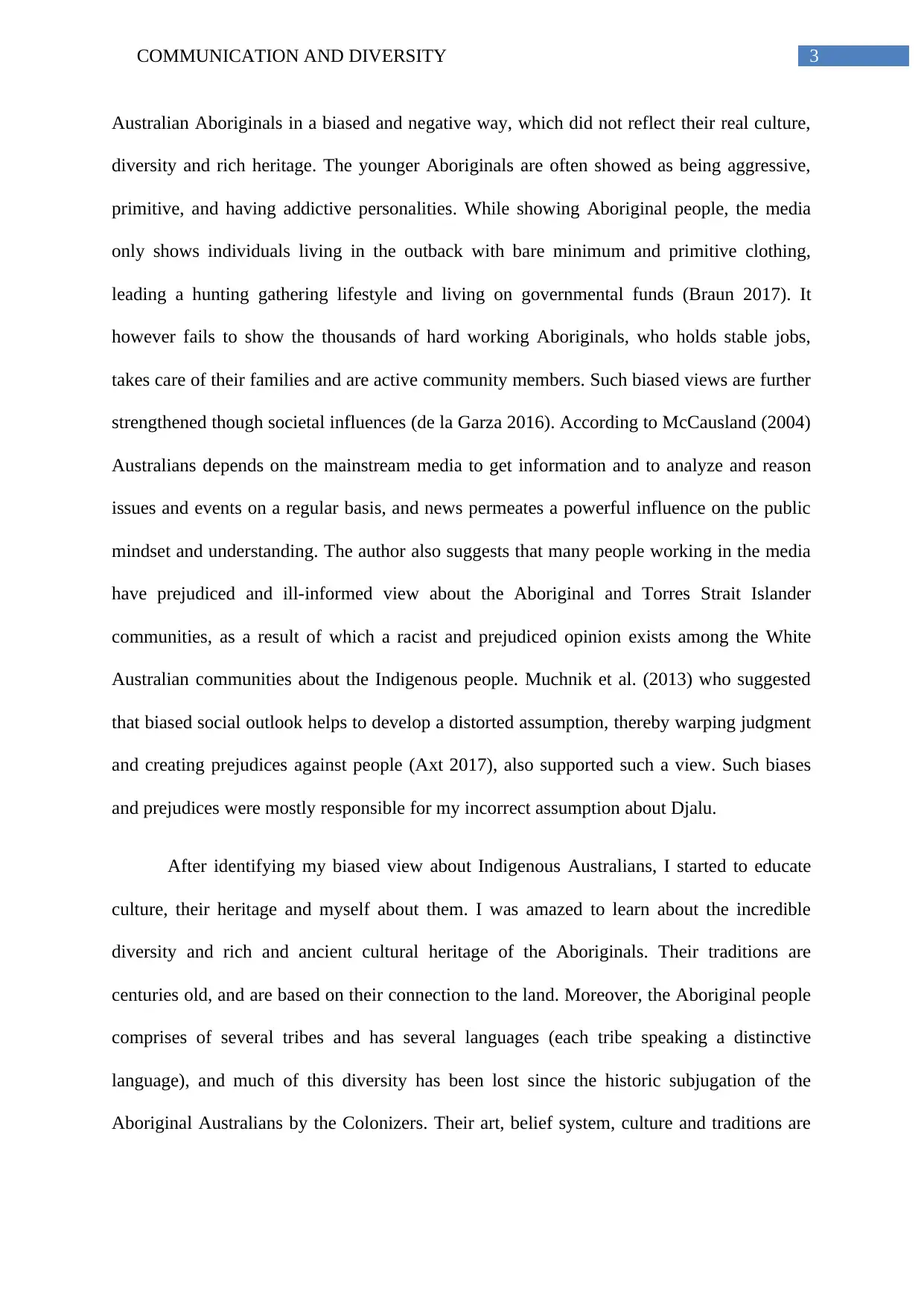
3COMMUNICATION AND DIVERSITY
Australian Aboriginals in a biased and negative way, which did not reflect their real culture,
diversity and rich heritage. The younger Aboriginals are often showed as being aggressive,
primitive, and having addictive personalities. While showing Aboriginal people, the media
only shows individuals living in the outback with bare minimum and primitive clothing,
leading a hunting gathering lifestyle and living on governmental funds (Braun 2017). It
however fails to show the thousands of hard working Aboriginals, who holds stable jobs,
takes care of their families and are active community members. Such biased views are further
strengthened though societal influences (de la Garza 2016). According to McCausland (2004)
Australians depends on the mainstream media to get information and to analyze and reason
issues and events on a regular basis, and news permeates a powerful influence on the public
mindset and understanding. The author also suggests that many people working in the media
have prejudiced and ill-informed view about the Aboriginal and Torres Strait Islander
communities, as a result of which a racist and prejudiced opinion exists among the White
Australian communities about the Indigenous people. Muchnik et al. (2013) who suggested
that biased social outlook helps to develop a distorted assumption, thereby warping judgment
and creating prejudices against people (Axt 2017), also supported such a view. Such biases
and prejudices were mostly responsible for my incorrect assumption about Djalu.
After identifying my biased view about Indigenous Australians, I started to educate
culture, their heritage and myself about them. I was amazed to learn about the incredible
diversity and rich and ancient cultural heritage of the Aboriginals. Their traditions are
centuries old, and are based on their connection to the land. Moreover, the Aboriginal people
comprises of several tribes and has several languages (each tribe speaking a distinctive
language), and much of this diversity has been lost since the historic subjugation of the
Aboriginal Australians by the Colonizers. Their art, belief system, culture and traditions are
Australian Aboriginals in a biased and negative way, which did not reflect their real culture,
diversity and rich heritage. The younger Aboriginals are often showed as being aggressive,
primitive, and having addictive personalities. While showing Aboriginal people, the media
only shows individuals living in the outback with bare minimum and primitive clothing,
leading a hunting gathering lifestyle and living on governmental funds (Braun 2017). It
however fails to show the thousands of hard working Aboriginals, who holds stable jobs,
takes care of their families and are active community members. Such biased views are further
strengthened though societal influences (de la Garza 2016). According to McCausland (2004)
Australians depends on the mainstream media to get information and to analyze and reason
issues and events on a regular basis, and news permeates a powerful influence on the public
mindset and understanding. The author also suggests that many people working in the media
have prejudiced and ill-informed view about the Aboriginal and Torres Strait Islander
communities, as a result of which a racist and prejudiced opinion exists among the White
Australian communities about the Indigenous people. Muchnik et al. (2013) who suggested
that biased social outlook helps to develop a distorted assumption, thereby warping judgment
and creating prejudices against people (Axt 2017), also supported such a view. Such biases
and prejudices were mostly responsible for my incorrect assumption about Djalu.
After identifying my biased view about Indigenous Australians, I started to educate
culture, their heritage and myself about them. I was amazed to learn about the incredible
diversity and rich and ancient cultural heritage of the Aboriginals. Their traditions are
centuries old, and are based on their connection to the land. Moreover, the Aboriginal people
comprises of several tribes and has several languages (each tribe speaking a distinctive
language), and much of this diversity has been lost since the historic subjugation of the
Aboriginal Australians by the Colonizers. Their art, belief system, culture and traditions are
Secure Best Marks with AI Grader
Need help grading? Try our AI Grader for instant feedback on your assignments.
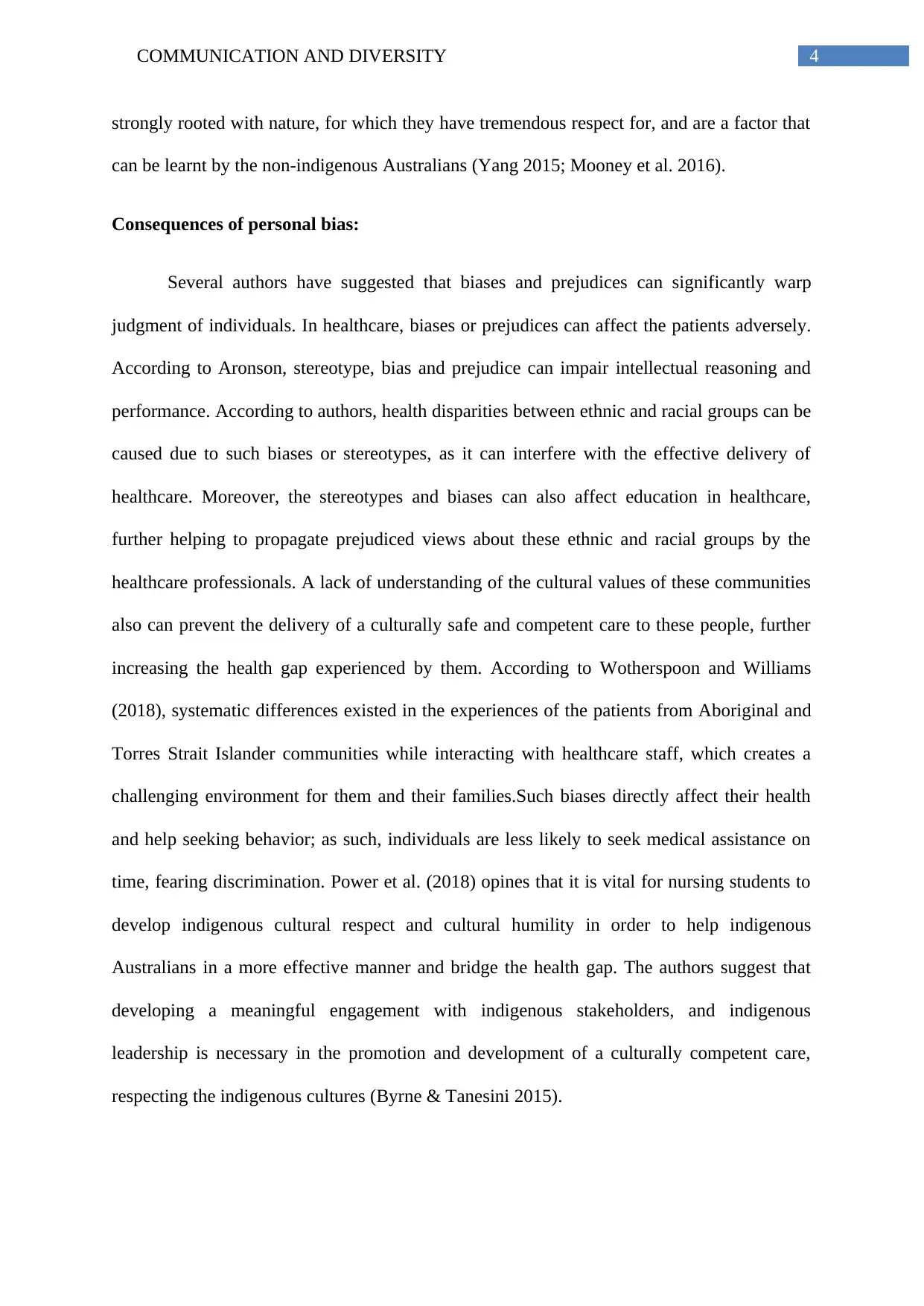
4COMMUNICATION AND DIVERSITY
strongly rooted with nature, for which they have tremendous respect for, and are a factor that
can be learnt by the non-indigenous Australians (Yang 2015; Mooney et al. 2016).
Consequences of personal bias:
Several authors have suggested that biases and prejudices can significantly warp
judgment of individuals. In healthcare, biases or prejudices can affect the patients adversely.
According to Aronson, stereotype, bias and prejudice can impair intellectual reasoning and
performance. According to authors, health disparities between ethnic and racial groups can be
caused due to such biases or stereotypes, as it can interfere with the effective delivery of
healthcare. Moreover, the stereotypes and biases can also affect education in healthcare,
further helping to propagate prejudiced views about these ethnic and racial groups by the
healthcare professionals. A lack of understanding of the cultural values of these communities
also can prevent the delivery of a culturally safe and competent care to these people, further
increasing the health gap experienced by them. According to Wotherspoon and Williams
(2018), systematic differences existed in the experiences of the patients from Aboriginal and
Torres Strait Islander communities while interacting with healthcare staff, which creates a
challenging environment for them and their families.Such biases directly affect their health
and help seeking behavior; as such, individuals are less likely to seek medical assistance on
time, fearing discrimination. Power et al. (2018) opines that it is vital for nursing students to
develop indigenous cultural respect and cultural humility in order to help indigenous
Australians in a more effective manner and bridge the health gap. The authors suggest that
developing a meaningful engagement with indigenous stakeholders, and indigenous
leadership is necessary in the promotion and development of a culturally competent care,
respecting the indigenous cultures (Byrne & Tanesini 2015).
strongly rooted with nature, for which they have tremendous respect for, and are a factor that
can be learnt by the non-indigenous Australians (Yang 2015; Mooney et al. 2016).
Consequences of personal bias:
Several authors have suggested that biases and prejudices can significantly warp
judgment of individuals. In healthcare, biases or prejudices can affect the patients adversely.
According to Aronson, stereotype, bias and prejudice can impair intellectual reasoning and
performance. According to authors, health disparities between ethnic and racial groups can be
caused due to such biases or stereotypes, as it can interfere with the effective delivery of
healthcare. Moreover, the stereotypes and biases can also affect education in healthcare,
further helping to propagate prejudiced views about these ethnic and racial groups by the
healthcare professionals. A lack of understanding of the cultural values of these communities
also can prevent the delivery of a culturally safe and competent care to these people, further
increasing the health gap experienced by them. According to Wotherspoon and Williams
(2018), systematic differences existed in the experiences of the patients from Aboriginal and
Torres Strait Islander communities while interacting with healthcare staff, which creates a
challenging environment for them and their families.Such biases directly affect their health
and help seeking behavior; as such, individuals are less likely to seek medical assistance on
time, fearing discrimination. Power et al. (2018) opines that it is vital for nursing students to
develop indigenous cultural respect and cultural humility in order to help indigenous
Australians in a more effective manner and bridge the health gap. The authors suggest that
developing a meaningful engagement with indigenous stakeholders, and indigenous
leadership is necessary in the promotion and development of a culturally competent care,
respecting the indigenous cultures (Byrne & Tanesini 2015).
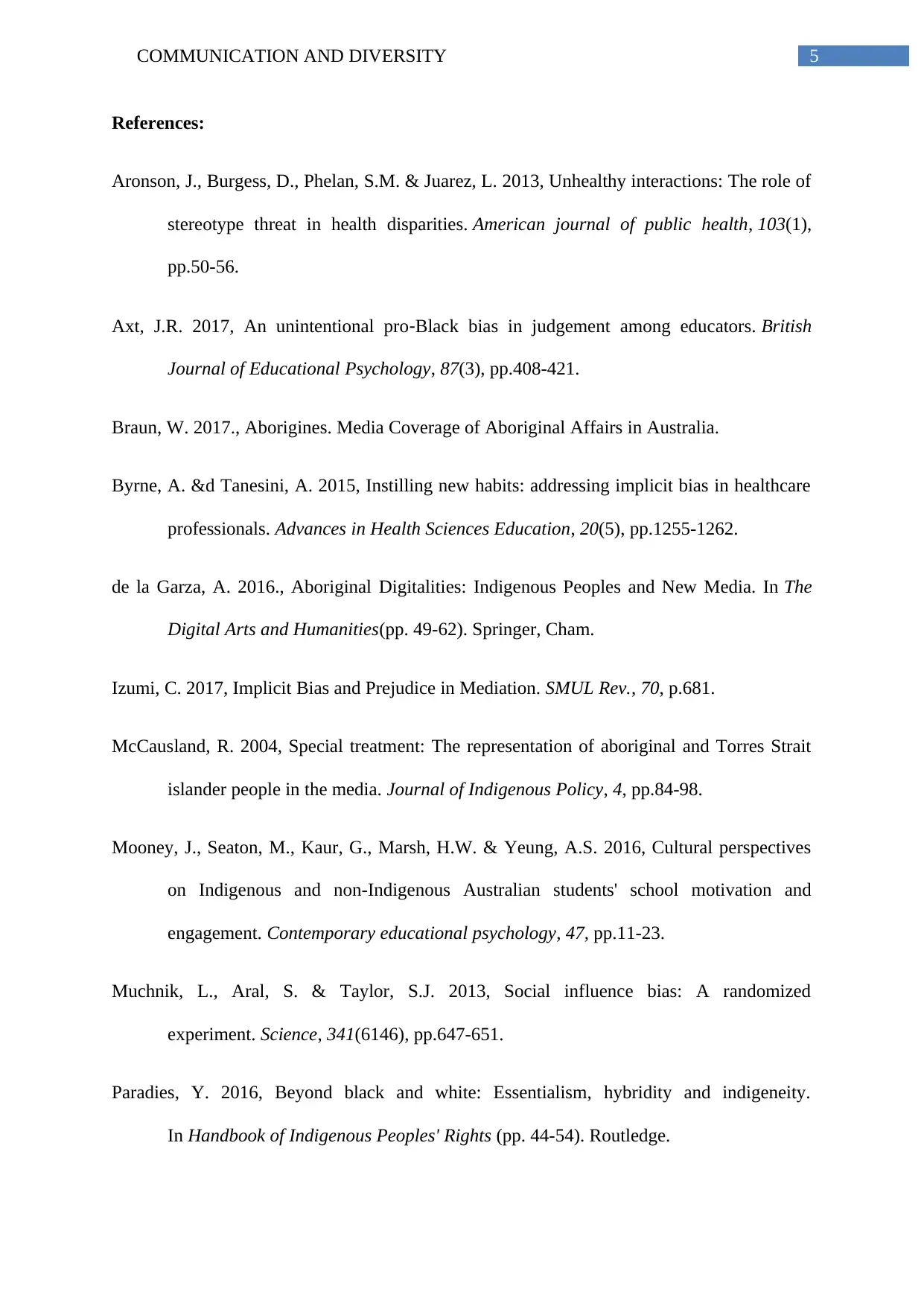
5COMMUNICATION AND DIVERSITY
References:
Aronson, J., Burgess, D., Phelan, S.M. & Juarez, L. 2013, Unhealthy interactions: The role of
stereotype threat in health disparities. American journal of public health, 103(1),
pp.50-56.
Axt, J.R. 2017, An unintentional pro‐Black bias in judgement among educators. British
Journal of Educational Psychology, 87(3), pp.408-421.
Braun, W. 2017., Aborigines. Media Coverage of Aboriginal Affairs in Australia.
Byrne, A. &d Tanesini, A. 2015, Instilling new habits: addressing implicit bias in healthcare
professionals. Advances in Health Sciences Education, 20(5), pp.1255-1262.
de la Garza, A. 2016., Aboriginal Digitalities: Indigenous Peoples and New Media. In The
Digital Arts and Humanities(pp. 49-62). Springer, Cham.
Izumi, C. 2017, Implicit Bias and Prejudice in Mediation. SMUL Rev., 70, p.681.
McCausland, R. 2004, Special treatment: The representation of aboriginal and Torres Strait
islander people in the media. Journal of Indigenous Policy, 4, pp.84-98.
Mooney, J., Seaton, M., Kaur, G., Marsh, H.W. & Yeung, A.S. 2016, Cultural perspectives
on Indigenous and non-Indigenous Australian students' school motivation and
engagement. Contemporary educational psychology, 47, pp.11-23.
Muchnik, L., Aral, S. & Taylor, S.J. 2013, Social influence bias: A randomized
experiment. Science, 341(6146), pp.647-651.
Paradies, Y. 2016, Beyond black and white: Essentialism, hybridity and indigeneity.
In Handbook of Indigenous Peoples' Rights (pp. 44-54). Routledge.
References:
Aronson, J., Burgess, D., Phelan, S.M. & Juarez, L. 2013, Unhealthy interactions: The role of
stereotype threat in health disparities. American journal of public health, 103(1),
pp.50-56.
Axt, J.R. 2017, An unintentional pro‐Black bias in judgement among educators. British
Journal of Educational Psychology, 87(3), pp.408-421.
Braun, W. 2017., Aborigines. Media Coverage of Aboriginal Affairs in Australia.
Byrne, A. &d Tanesini, A. 2015, Instilling new habits: addressing implicit bias in healthcare
professionals. Advances in Health Sciences Education, 20(5), pp.1255-1262.
de la Garza, A. 2016., Aboriginal Digitalities: Indigenous Peoples and New Media. In The
Digital Arts and Humanities(pp. 49-62). Springer, Cham.
Izumi, C. 2017, Implicit Bias and Prejudice in Mediation. SMUL Rev., 70, p.681.
McCausland, R. 2004, Special treatment: The representation of aboriginal and Torres Strait
islander people in the media. Journal of Indigenous Policy, 4, pp.84-98.
Mooney, J., Seaton, M., Kaur, G., Marsh, H.W. & Yeung, A.S. 2016, Cultural perspectives
on Indigenous and non-Indigenous Australian students' school motivation and
engagement. Contemporary educational psychology, 47, pp.11-23.
Muchnik, L., Aral, S. & Taylor, S.J. 2013, Social influence bias: A randomized
experiment. Science, 341(6146), pp.647-651.
Paradies, Y. 2016, Beyond black and white: Essentialism, hybridity and indigeneity.
In Handbook of Indigenous Peoples' Rights (pp. 44-54). Routledge.
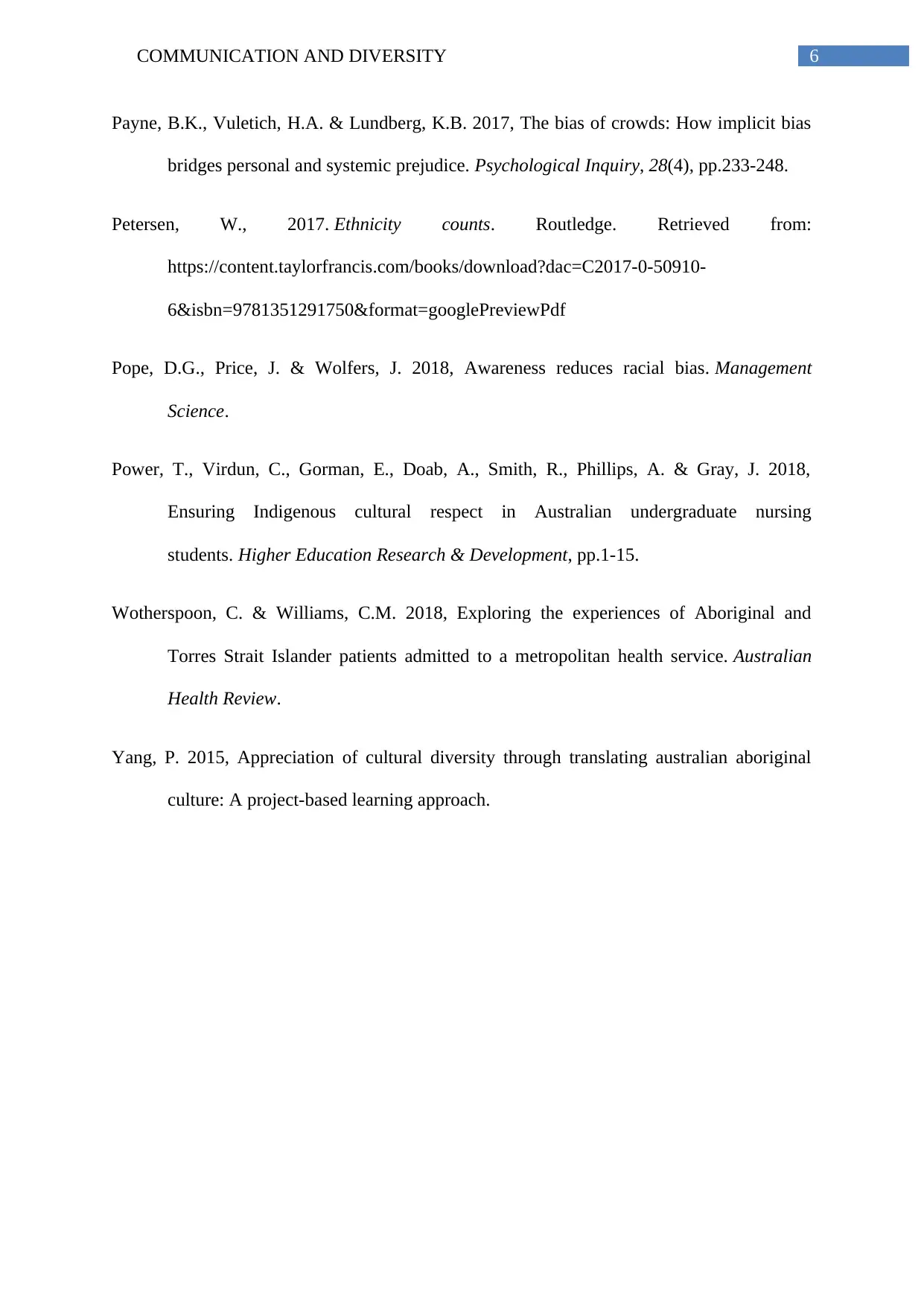
6COMMUNICATION AND DIVERSITY
Payne, B.K., Vuletich, H.A. & Lundberg, K.B. 2017, The bias of crowds: How implicit bias
bridges personal and systemic prejudice. Psychological Inquiry, 28(4), pp.233-248.
Petersen, W., 2017. Ethnicity counts. Routledge. Retrieved from:
https://content.taylorfrancis.com/books/download?dac=C2017-0-50910-
6&isbn=9781351291750&format=googlePreviewPdf
Pope, D.G., Price, J. & Wolfers, J. 2018, Awareness reduces racial bias. Management
Science.
Power, T., Virdun, C., Gorman, E., Doab, A., Smith, R., Phillips, A. & Gray, J. 2018,
Ensuring Indigenous cultural respect in Australian undergraduate nursing
students. Higher Education Research & Development, pp.1-15.
Wotherspoon, C. & Williams, C.M. 2018, Exploring the experiences of Aboriginal and
Torres Strait Islander patients admitted to a metropolitan health service. Australian
Health Review.
Yang, P. 2015, Appreciation of cultural diversity through translating australian aboriginal
culture: A project-based learning approach.
Payne, B.K., Vuletich, H.A. & Lundberg, K.B. 2017, The bias of crowds: How implicit bias
bridges personal and systemic prejudice. Psychological Inquiry, 28(4), pp.233-248.
Petersen, W., 2017. Ethnicity counts. Routledge. Retrieved from:
https://content.taylorfrancis.com/books/download?dac=C2017-0-50910-
6&isbn=9781351291750&format=googlePreviewPdf
Pope, D.G., Price, J. & Wolfers, J. 2018, Awareness reduces racial bias. Management
Science.
Power, T., Virdun, C., Gorman, E., Doab, A., Smith, R., Phillips, A. & Gray, J. 2018,
Ensuring Indigenous cultural respect in Australian undergraduate nursing
students. Higher Education Research & Development, pp.1-15.
Wotherspoon, C. & Williams, C.M. 2018, Exploring the experiences of Aboriginal and
Torres Strait Islander patients admitted to a metropolitan health service. Australian
Health Review.
Yang, P. 2015, Appreciation of cultural diversity through translating australian aboriginal
culture: A project-based learning approach.
1 out of 7
Related Documents
Your All-in-One AI-Powered Toolkit for Academic Success.
+13062052269
info@desklib.com
Available 24*7 on WhatsApp / Email
![[object Object]](/_next/static/media/star-bottom.7253800d.svg)
Unlock your academic potential
© 2024 | Zucol Services PVT LTD | All rights reserved.
